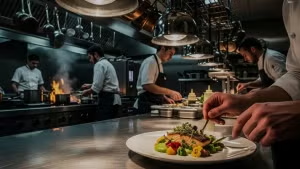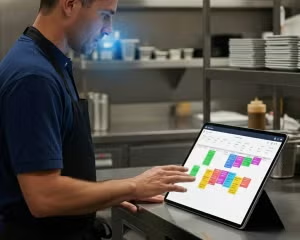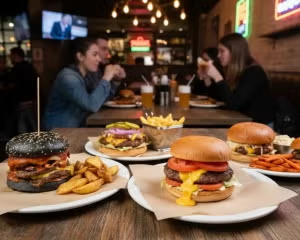According to the U.S. Census Bureau, sales at eating and drinking spots totaled $49.6 billion in December 2014 and $49.4 billion in November 2014. These were both record volumes, signifying that the American appetite for restaurant dining during the holiday season is growing.
Competition for holiday-dining dollars is also growing, so savvy restaurateurs must maximize holiday-business opportunities. Here’s how:
Be strategic
Start planning early and begin promoting holiday activities in October. Even earlier if corporate catering is on your agenda.
“Set your holiday plans as part of your yearly strategy,” says Gordon Food Service Commercial Segment Leader Todd Gross, CEC.”
Make sales forecasting a key part of your strategy. Use past holiday-sales data from your POS system to help determine inventory and staffing needs.
Promote sharing
Sharing meals with family and friends is a holiday tradition. They’re a natural for large groups, but also appeal to shoppers. No sharing-plates menu? Upsize your appetizers and train staff to promote them.
Indulge guests
“People are in a mood to splurge at the holidays,” Gross says. Create indulgent specialty items that generate excitement and boost your bottom line.
Add seasonal flavors
Portland, Oregon-based pastry chef Michelle Vernier says seasonal flavors are a must. At Thanksgiving, she incorporates apples—especially heirloom varieties—pumpkins, specialty winter squash, bourbon, pecans, sweet potato, and cranberry. In December, it’s peppermint, chocolate, bright citrus, and “boozy” coffee.
Take shortcuts
Menu creatively plated thaw-and-serve desserts. Flavored syrups—mint, cinnamon, hazelnut, white chocolate—add a quick “shot of the season” to coffees and shakes.
Remember the basics
Execution matters more than anything else during the holidays, maintains Gordon Food Service Commercial Segment Specialist Geoff Bonham. “The best way to build customer loyalty is to execute your traditional menu well.” You must also consistently deliver on the basics—friendliness, cleanliness, and timeliness. This can make regulars out of first-timers brought to your restaurant as holiday guests.
Go with gift cards
Technomic Inc. reported that 51 percent of consumers gave gift cards during the 2013 holiday season. But gift-card redemption rates can be as low as 60 percent, according to Gordon Food Service Grocery/Bakery product specialist Bill Barker.
“That’s a lot free money for operators,” Barker says. “Do away with paper gift certificates; use cards with no cash refunds. Usually cards with small amounts left on them get discarded.”
Remember, though, that most cards are used in January and February. “That means less actual cash coming in during traditionally slow months,” Barker says. “Budget for that.”
Think catering
Holiday catering is an excellent way to boost revenue. Decide what you can realistically accomplish given your people, space, and brand.
“Start promoting to corporate customers as early as August or September,” Gross urges. “Weekends will fill up fast, so consider a discounted rate to push people to Mondays or Tuesdays.”
If you can’t manage full-blown catering, offer three or four of your best (and most profitable) items that customers can order for home and office parties. “Set up a separate catering phone number staffed by someone who knows the policies and procedures,” Barker advises.
Train (and retrain)
New hires should receive the same training in November that they would in April. Anything less puts your brand at risk and impedes your ability to create return customers. Emphasize the need to make customers feel at home for the holidays. “Thank you for sharing your holiday season with us,” and “I hope you’ll come back and see us again real soon” are the messages you want to impart.
Be sure to keep all staff in the loop about holiday hours, menu changes, and anticipated business traffic.
Staff smart
Higher traffic requires more staff. Don’t skimp on manpower, says Dan Longton, President and CEO of Florida-based TraitSet, a workforce-management service provider. “Don’t overschedule, either; that will eat into your profits. So will overtime.” Base this year’s schedule on last year’s data—an easier prospect if you’ve automated the scheduling function.
Of course, for foodservice employees, the holidays can be doubly hectic given the personal demands of the season. One way to make it easier on employees is to set their expectations ahead of time. Vernier, for example, makes it clear during the hiring process that time-off requests from November through January 1 can’t be accommodated. Built within that policy, however, are ways to help employees.
“I try to spread it out so staff work shorter shifts, and I work hard to make sure staff know they are appreciated,” Vernier explains.
Get the word out
Promote holiday offerings to existing customers—via emails, text messages, social-media platforms, and in-store table tents—as soon as you have something concrete to share. Tease photos of new holiday dishes. Announce expanded hours. Give customers first crack at New Year’s Eve reservations.
All the while, Barker advises, “Keep a holiday diary with notes on how each day went, hourly readings, schedules, problems, and successes. That will give you a leg up for next year.”











